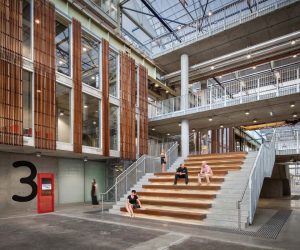
Mitsubishi MDT701S LCD Display Panel
When size matters.
Text:/ Stuart Gregg
The latest monitor from Mitsubishi Electric is a 70-inch (1765mm) full high definition LCD panel with LED backlight. From the moment we unpacked it there was no mistaking it has been built to last – you could be forgiven for thinking it was going to be a lot heavier than its actual 45kg. The bezel and case are solid and will stand the life of a rental unit even though installation and digital signage are clearly where it’s aimed. And while solid, the bezel does not spoil the look of the model (it can be removed for certain installations but this will invalidate the unit’s UL compliance).
UP AGAINST THE WALL
The monitor is designed for wall mounting and is thinner than previous models, sitting slim against the wall once the handles are removed. All the input sockets are designed to facilitate mounting close to the wall; the control buttons, however, are rear mounted on the lower right of the panel and tricky to access – you will need very slim fingers if you ever lose the remote. That said, most installed monitors are likely to be managed via the RS232 or LAN using either Mitsubishi’s own protocol or the ever popular Crestron and AMX.
A good choice of signal inputs offered as standard include:
D-Sub – computer or YPbPr
DVI-D with loop through
2 x HDMI
Display port
Composite video – via BNC
S-Video (mini DIN 4-pin)
Analogue audio (stereo mini jack) with loop through
As an option an SDI input for SD, HD and 3G SDI signals can be added and there is an OPS (open pluggable specification) expansion slot for installing an onboard PC or media player. Alongside the signal inputs is a built in USB hub that can be used to connect peripherals to an external computer or an optional on board unit using the OPS slot. The monitor has internal speakers that do a respectable job, as well as external speaker terminals.
A GOOD SIGN
Mitsubishi has included a host of features for the digital signage user, some of which are geared for larger and more complex installations. Others such as the built in scheduling function, OPS slot and ambient light sensors, make it a great unit for simple stand-alone use.
The scheduling function gives you the ability to set seven different schedules, with settings by day and hour for power on/off and input selection. The ambient light sensors makes use of front and back light sensors to control the brightness of the image and take into consideration not just the light falling on the front of the panel, but also behind it. We found it worked reasonably well and was unobtrusive in its adjustments. The function can also be turned off if it isn’t required.
The monitor can be tiled for videowall style installations up to a 5×5 configuration, and built in frame compensation allows images to display as the eye and mind want to see them.
PIP, POP and side-by-side display option are available and work on full HD signals, and the ubiquitous zoom function is available for aspect correction and image zoom – not that I have ever had the need to zoom an image, but maybe that’s just me.
CARE AND FEEDING
We connected a Mac laptop (non retina model) via DVI, a Blu-ray player via HDMI, a PC via both displayport and VGA, and a DVD player on both component (YPbPr) and composite.
The computer signals all came up looking good, with no need for any timing adjustments, although there is an option to adjust HV size and shifts for all computers and clock and phase on the analogue computer inputs. The monitor will accept resolutions from 640×480 up to 1920×1200 (compressed/simplified).
Gamma is selectable from Native, S Gamma, 2.2, 2.4 or programmable. The programmable function is via a computer and enables adjustment of the curve.
All computer pictures were sharp with vibrant colours and great contrast. The only complaint we had was that the images looked great front on and from angles up to 40° off-centre, and from then on the image didn’t lose punch but the apparent gamma shifted markedly. It didn’t look bad off-axis, but was distinctly different from the on-axis image; you could chase your tail adjusting the monitor to compensate.
The Blu-ray images reproduced well – both live studio footage and moody movie scenes were impressive with good detail in the darker scenes. We had a try with the Clear Picture mode, which takes images displayed at 60 frames per second and interpolates them into 120 frames for smoother motion, but were undecided with the results.
The remote is laid out well, and the menu structure is intuitive and easy to follow. Overall, Mitsubishi is offering a well-built, nicely featured unit that would work well in a digital signage install as well as for AV rental stock. However, the off-axis image variance we experienced might be an issue in some circumstances and it would not be my choice for a videowall array. RRP is $11,790 (inc GST) and you should see it coming to a shopping centre or airport near you soon.
Mitsubishi Electric:
www.mitsubishielectric.com.au
















RESPONSES